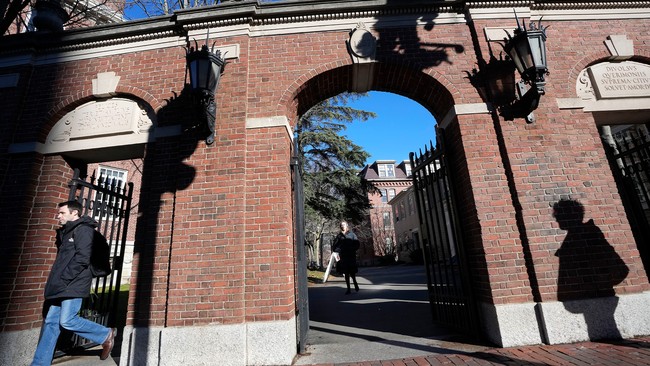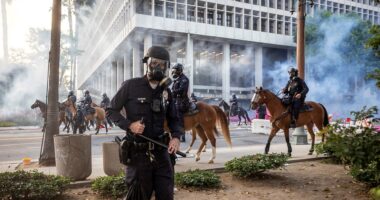
By
According to college administrators like Harvard University President Alan Garber, Trump lacks the legal authority to intervene in their operations, and such interference could potentially harm academic freedom. Nevertheless, the acceptance of federal funds grants the government influence over various aspects of colleges and universities, a power defined by long-standing legislation. Consequently, government funding poses a substantial threat to academic freedom.
Prior to Trump’s presidency, no other president had attempted to challenge these educational institutions. The influx of government funding, including student aid programs, loan guarantees, direct grants, and tax-exempt status for donations, shielded administrators from accountability to market forces and allowed universities to cater to the demands of radical activists without repercussions. Federal expenditure on higher education skyrocketed from $0.193 billion in 1960 to $42 billion in 2023, as reported by the St. Louis Fed. Overall, federal and state funding for higher education surged from $1.69 billion to $250.7 billion over the same period.
These financial injections bolstered the finances of colleges and universities, leading to a substantial increase in the average published annual tuition and fees for private nonprofit four-year institutions from $24,840 in 1994 to $43,350 in 2024 (adjusted for inflation). Notably, these tuition hikes were accompanied by a significant expansion in administrative personnel and the introduction of comprehensive diversity, equity, and inclusion (DEI) initiatives.
With so much taxpayer money flowing in, American college and university administrators transformed their institutions into virtual ideological monopolies while enjoying cover from the media and activist groups. They openly favored women and nonwhites in admissions and hiring and allowed leftist activists to shout down alternative viewpoints and even commit violence without consequences.
The Supreme Court’s 2023 decision against affirmative action ended racial preferences, knocking down the premise for all those DEI systems. Now, Trump is demanding that these institutions obey the nation’s laws in exchange for all that taxpayer money.
As Northwestern University constitutional law professor John O. McGinnis writes at Law & Liberty, “The structure of civil rights laws as applied to universities has long allowed the federal government to cut off funding to the entire university based on the wrongful actions of particular units or departments.”
Trump has set out to do so, unleashing chaos, uncertainty, and unrest throughout the nation’s colleges and universities. In response, the administrators of these institutions have sided with the activists against the interests of students and faculty. Scholars and researchers are suffering because of this conflict.
Harvard’s hope, and that of others in the same situation, is obviously that the courts will step in and block Trump’s actions. What Trump is doing, however, is neither unprecedented nor unconstitutional. Writing at Blaze Media, Joseph MacKinnon provides multiple examples of the Obama and Biden administrations’ threats and actions against colleges’ and universities’ federal funding and tax-exempt status, such as Obama’s requiring colleges to deny due process to people accused of sexual assault or harassment.
College and university administrators did not complain. They agreed with those policies and had already been implementing them. These actions, however, “paved the way for those issued in recent weeks by the Trump administration,” MacKinnon writes.
The administrators now have little leverage, legal or otherwise. Declining birth rates since 2007 are about to push colleges off a fiscal cliff starting this fall, as the first fruits of a rapidly shrinking youth cohort reach college age. “[C]olleges and universities already collectively experienced a 15% decline in enrollment between 2010 and 2021, the most recent year for which figures are available, according to the National Center for Education Statistics,” NPR reports, and the decline is accelerating.
On top of that, smaller percentages of young people are choosing to go to college. “Among high school graduates, the proportion going straight to college has fallen, from a peak of 70% in 2016 to 62% in 2022, the most recent year for which the figure is available,” NPR reports.
That reflects rapidly growing public disenchantment with the nation’s colleges and universities. “[I]n 2023, a Gallup poll found that only 36% of Americans had a high level of confidence in higher education,” reports College Consensus. That is a serious decline from 48 percent in 2018 and 57 percent in 2015.
As the incoming age cohort shrinks and fewer people trust these institutions, smaller and less-prestigious colleges and universities are closing, an average of two per month at present.
America’s institutions of higher education have a long and luminous history of achievements. Unfortunately, government money has undermined administrators’ respect for their core missions, reduced the trust of students and the American people, and placed these institutions in bondage to politicians.
Someone or something is going to have to break the money-forged bond between academia and government. It would be best for the colleges and universities to embrace the process, make the best deals they can with Trump, and begin weaning themselves from government money—and control.
If they don’t, they will have only themselves to blame for the destruction of these valuable institutions and the casting adrift of thousands of decent, hardworking scientists and scholars.
S. T. Karnick (https://stkarnick.substack.com/) is a senior fellow at The Heartland Institute and author of the Life, Liberty, Property weekly e-newsletter.

















